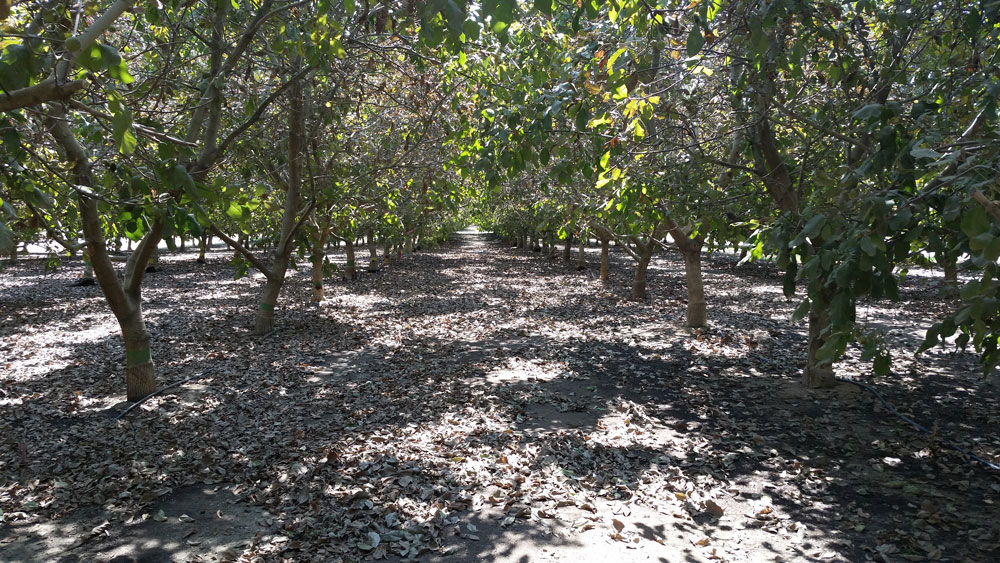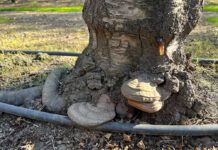
PCAs and growers reported high mite pressure in walnuts last year, particularly in the Sacramento and northern San Joaquin valleys, according to UCCE Farm Advisors Franz Niederholzer and Luke Milliron as well as Area IPM Advisor Jhalendra Rijal.
“Usually, in walnuts, you have some mite activity,” said Rijal, an advisor for the northern San Joaquin Valley. “But usually, it is late in the season. This past year, they started in the early part of the season.”
Mite presence late in the season generally is not problematic, Rijal said, given that by then, predatory mite populations have built up and the main damage mites cause (loss of leaves) isn’t as important as in early season. But, researchers said, heavy mite pressure early in the season should be addressed.
“An orchard’s motor is the leaves,” said Niederholzer, farm advisor for Colusa, Sutter and Yuba counties, “so when you take away the leaves, you can have more sunburned nuts and you may have smaller nuts at harvest. You end up kind of limping along with a reduced leaf area, especially if the mite outbreak is earlier in the season.
“[A mite outbreak] reduces the vigor of an orchard and it is certainly not something you want to have during a drought,” he added.
Early Monitoring
Rijal advised growers to start looking for spider mites as early as late April. Early season scouting can be done with less frequency than mid-season scouting, he said, and can be concentrated on areas most prone to mites, such as stressed trees or near dirt roads.
By late June or early July, scouting should be occurring weekly, according to UC IPM guidelines, and should continue at that pace through August. The guidelines recommend randomly selecting samples from ten trees in an orchard and picking five leaflets from low branches and five from high branches in each tree.
Treatment thresholds are based not only on the presence of spider mites, but also on the presence of predators and whether a broad-spectrum insecticide was used to control pests such as codling moth or walnut husk fly.
In cases, where a pyrethroid was used, for example, a miticide may be warranted if predators are present on fewer than 10% of mite-infested leaves when 10% of leaves have spider mites. Whereas absence a pyrethroid, sprays are not recommended until 30% to 40% of leaves are mite infested and predators are present on fewer than 10% of mite-infested leaves.
“The bottom line,” Rijal said, “is if you apply broad-spectrum insecticides early in the season, you can expect mite activity. And whenever you are doing mite counts or doing sampling, you also should do it for predators, too.”
Easy to Differentiate
Rijal said it is easy to differentiate between predator mites and the twospotted or Pacific spider mite. “The spider mite is always this kind of greenish mite with two spots on their body, and they basically hunker down on the leaf surface and pretty much feed there, more like a stationary creature,” he said. “The predator mite moves around a lot, and the majority of these predator mites have more like a clear body type.”
Rijal added that walnuts orchards often have a rich diversity of predatory mite species.
When treating for mites, Rijal advised growers to consider using slower-acting materials, such as growth regulators like spirodiclofen, hexythiazox and etoxazole. “Those do a good job when there is low to moderate mite pressure,” he said. Other good options he identified are bifenazate, cyflumetofen and fenpyromixate, depending on the orchard mite pressure and costs.
He discouraged growers from using abamectin, particularly early in the season, given the material’s potential negative effect on sixspotted thrips, a predator of spider mites.
Dust in orchards can contribute to mite population increases, he added, so growers should consider watering or putting down some oil on dirt roadways. “The dust collects on the leaves, which tends to dry leaves, and that is favorable for mites,” Rijal said.
Combination of Factors
Rijal and Niederholzer attributed last summer’s mite outbreak in walnuts to a variety of factors, including drought and use of pyrethroids to control high codling moth pressure.
“Pyrethroids are inexpensive and effective, and have some obvious upsides for growers in a down market,” Niederholzer said. “But they have some significant downsides from a management standpoint.”
Rijal said codling moth activity was low in the San Joaquin Valley for much of last summer, but not in the Sacramento Valley, which could have driven some spray decisions.
“Some of the collaborative studies we are doing in the Sacramento Valley indicate that much more codling moth pressure, at least early in the season, is requiring insecticide sprays,” he said. “So, there could have been some sprays that contributed to mite flare-ups.”
When treating for codling moth, growers should consider using lepidopterous-specific insecticides, Rijal said. “They are more expensive than pyrethroids, but in the long run, they can save you money.”
Use of neonicotinoids to control husk fly also could have exacerbated issues with mites last year, Niederholzer said, given that research has shown that they can increase the fecundity of spider mites.
Another factor in the increased mite pressure in walnuts in the Sacramento Valley and northern San Joaquin Valley could be an inherent difficulty in spraying the crop for mites. “It is harder to take care of mites in walnuts than it is in almonds,” Niederholzer said, “mainly because of the size of the trees. Mature orchards can be very tall. You have to drive really slowly to get spray to the tree tops. You have to use a lot of water to cover the acres of leaves in an acre of trees. It takes a lot of time to do a good job.
“It is a real challenge,” he said.
Still, Rijal said, the biggest reason for the increase mite pressure last year was probably drought.
“Probably that is the major reason why we had a lot more mite activity from the beginning of the season this past year,” Rijal said. “If there are favorable conditions, mite populations can multiply very fast. And mites love dry conditions.”
Also, Rijal said, water-use restrictions in place in some orchards last year could have been a contributing factor. “It is a two-fold thing,” he said. “They might have used less water and there were drier conditions early in the season. I think that was the main reason.”
Dramatic Effect
Niederholzer added that when mites do strike an orchard, the effect is dramatic.
“Nothing is worse than a mite outbreak when it comes to how the orchard looks, because you lose a lot of leaves,” he said. “The whole orchard looks terrible in a mite outbreak.”
Whether or not mites return to walnut orchards next year is anybody’s guess, according to Rijal. “You never know with mites,” Rijal said. “It depends on spray programs and environmental conditions.”
But, regardless of pressure, evidence shows growers can minimize crop damage to mites by keeping a close watch for the pest and selecting spray materials that reduce flare-ups.















